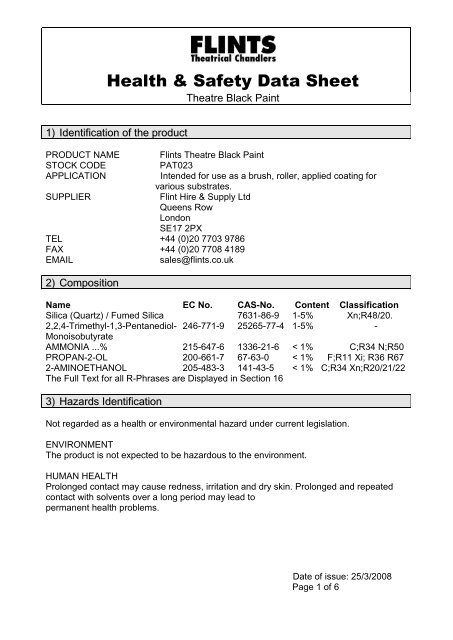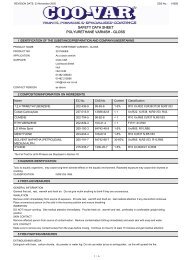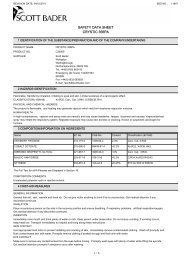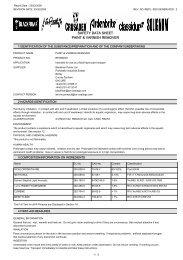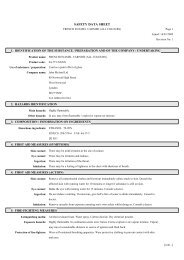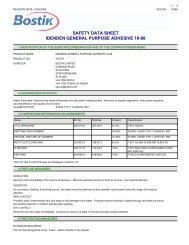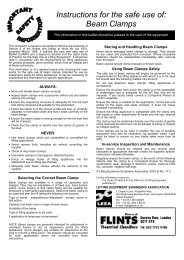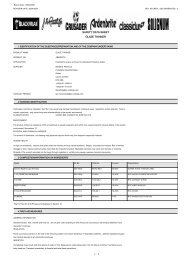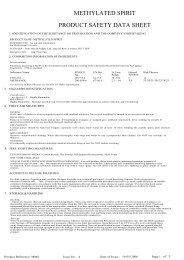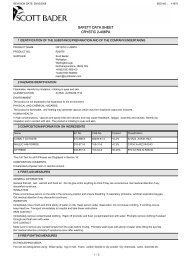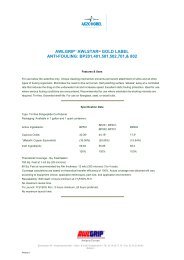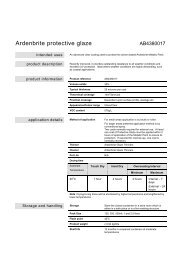Flints Theatre Black Paint - Flint Hire & Supply
Flints Theatre Black Paint - Flint Hire & Supply
Flints Theatre Black Paint - Flint Hire & Supply
Create successful ePaper yourself
Turn your PDF publications into a flip-book with our unique Google optimized e-Paper software.
Health & Safety Data Sheet<br />
<strong>Theatre</strong> <strong>Black</strong> <strong>Paint</strong><br />
1) Identification of the product<br />
PRODUCT NAME <strong><strong>Flint</strong>s</strong> <strong>Theatre</strong> <strong>Black</strong> <strong>Paint</strong><br />
STOCK CODE<br />
PAT023<br />
APPLICATION<br />
Intended for use as a brush, roller, applied coating for<br />
various substrates.<br />
SUPPLIER<br />
<strong>Flint</strong> <strong>Hire</strong> & <strong>Supply</strong> Ltd<br />
Queens Row<br />
London<br />
SE17 2PX<br />
TEL +44 (0)20 7703 9786<br />
FAX +44 (0)20 7708 4189<br />
EMAIL<br />
sales@flints.co.uk<br />
2) Composition<br />
Name EC No. CAS-No. Content Classification<br />
Silica (Quartz) / Fumed Silica 7631-86-9 1-5% Xn;R48/20.<br />
2,2,4-Trimethyl-1,3-Pentanediol- 246-771-9 25265-77-4 1-5% -<br />
Monoisobutyrate<br />
AMMONIA ...% 215-647-6 1336-21-6 < 1% C;R34 N;R50<br />
PROPAN-2-OL 200-661-7 67-63-0 < 1% F;R11 Xi; R36 R67<br />
2-AMINOETHANOL 205-483-3 141-43-5 < 1% C;R34 Xn;R20/21/22<br />
The Full Text for all R-Phrases are Displayed in Section 16<br />
3) Hazards Identification<br />
Not regarded as a health or environmental hazard under current legislation.<br />
ENVIRONMENT<br />
The product is not expected to be hazardous to the environment.<br />
HUMAN HEALTH<br />
Prolonged contact may cause redness, irritation and dry skin. Prolonged and repeated<br />
contact with solvents over a long period may lead to<br />
permanent health problems.<br />
Date of issue: 25/3/2008<br />
Page 1 of 6
4) First Aid Measures<br />
Health & Safety Data Sheet<br />
<strong>Theatre</strong> <strong>Black</strong> <strong>Paint</strong><br />
GENERAL INFORMATION<br />
General first aid, rest, warmth and fresh air. Do not give victim anything to drink if they<br />
are unconscious. Get medical attention if any discomfort continues.<br />
INHALATION<br />
Place unconscious person on the side in the recovery position and ensure breathing If<br />
respiratory problems, artificial respiration/oxygen. Get medical attention if any discomfort<br />
continues.<br />
INGESTION<br />
Immediately rinse mouth and drink plenty of water or milk. Keep person under<br />
observation. Do not induce vomiting. If vomiting occurs, keep head low. Transport<br />
immediately to hospital and take these instructions.<br />
SKIN CONTACT<br />
Use appropriate hand lotion to prevent defatting and cracking of skin. Immediately<br />
remove contaminated clothing. Wash off promptly and flush contaminated skin with<br />
water. Promptly remove clothing if soaked through and flush skin with water.<br />
EYE CONTACT<br />
Make sure to remove any contact lenses from the eyes before rinsing. Promptly wash<br />
eyes with plenty of water while lifting the eye lids. Get medical attention promptly if<br />
symptoms occur after washing.<br />
5) Fire-Fighting Measures<br />
EXTINGUISHING MEDIA<br />
This product is not flammable. Use fire-extinguishing media appropriate for surrounding<br />
materials.<br />
SPECIAL FIRE FIGHTING PROCEDURES<br />
Use pressurised air mask if product is involved in a fire. Cool containers exposed to<br />
flames with water until well after the fire is out. Keep<br />
run-off water out of sewers and water sources. Dike for water control.<br />
UNUSUAL FIRE & EXPLOSION HAZARDS<br />
Fire causes formation of toxic gases.<br />
PROTECTIVE MEASURES IN FIRE<br />
Self contained breathing apparatus and full protective clothing must be worn in case of<br />
fire.<br />
6) Accidental Release Measures<br />
PERSONAL PRECAUTIONS<br />
Wear protective clothing as described in Section 8 of this safety data sheet.<br />
ENVIRONMENTAL PRECAUTIONS<br />
Spillages or uncontrolled discharges into watercourses must be IMMEDIATELY alerted<br />
to the Environmental Agency or other appropriate regulatory body.<br />
SPILL CLEAN UP METHODS<br />
Absorb in vermiculite, dry sand or earth and place into containers. Wash thoroughly after<br />
dealing with a spillage.<br />
Date of issue: 25/3/2008<br />
Page 2 of 6
7) Handling & Storage<br />
Health & Safety Data Sheet<br />
<strong>Theatre</strong> <strong>Black</strong> <strong>Paint</strong><br />
USAGE PRECAUTIONS<br />
Avoid spilling, skin and eye contact. Ventilate well, avoid breathing vapours. Use<br />
approved respirator if air contamination is above accepted level.<br />
STORAGE PRECAUTIONS<br />
Store in tightly closed original container in a cool, dry well-ventilated place. Keep in<br />
original container. Avoid contact with oxidising agents.<br />
8) Exposure Controls/Personal Protection<br />
Name Std LT - ppm LT - mg/m3 ST - ppm ST - mg/m3<br />
AMMONIA ...% WEL 25 ppm 18 mg/m3 35 ppm 25 mg/m3<br />
PROPAN-2-OL WEL 400 ppm 999 mg/m3 500 ppm 1250 mg/m3<br />
2-AMINOETHANOL WEL 3 ppm 7.6 mg/m3 6 ppm 15 mg/m3<br />
INGREDIENT COMMENTS<br />
WEL = Workplace Exposure Limits<br />
PROTECTIVE EQUIPMENT<br />
Goggles and gloves should be worn<br />
PROCESS CONDITIONS<br />
Provide eyewash station.<br />
ENGINEERING MEASURES<br />
Provide adequate ventilation, including appropriate local extraction, to ensure that the<br />
defined workplace exposure limit is not exceeded.<br />
All handling to take place in well-ventilated area.<br />
RESPIRATORY EQUIPMENT<br />
Provide adequate ventilation. Observe Workplace Exposure Limits and minimise the risk<br />
of inhalation of vapours.<br />
HAND PROTECTION<br />
Protective gloves should be used if there is a risk of direct contact or splash.<br />
EYE PROTECTION<br />
Wear splash-proof eye goggles to prevent any possibility of eye contact.<br />
OTHER PROTECTION<br />
Wear appropriate clothing to prevent any possibility of skin contact.<br />
HYGIENE MEASURES<br />
DO NOT SMOKE IN WORK AREA! Wash at the end of each work shift and before<br />
eating, smoking and using the toilet. Promptly remove<br />
any clothing that becomes contaminated. Use appropriate skin cream to prevent drying<br />
of skin. When using do not eat, drink or smoke.<br />
9) Physical and Chemical Properties<br />
APPEARANCE Liquid<br />
COLOUR <strong>Black</strong><br />
ODOUR Mild<br />
Date of issue: 25/3/2008<br />
Page 3 of 6
Health & Safety Data Sheet<br />
<strong>Theatre</strong> <strong>Black</strong> <strong>Paint</strong><br />
SOLUBILITY Miscible with water.<br />
RELATIVE DENSITY 1.04 approx 20C VAPOUR DENSITY (air=1) Heavier than air<br />
pH-VALUE, CONC. SOLUTION 7 - 8 FLASH POINT (°C) n/a<br />
10) Stability and Reactivity<br />
STABILITY<br />
No particular stability concerns.<br />
HAZARDOUS DECOMPOSITION PRODUCTS<br />
Thermal decomposition or combustion may liberate carbon oxides and other toxic gases<br />
or vapours.<br />
11) Toxicological Information<br />
GENERAL INFORMATION<br />
Not regarded as a health hazard under current legislation.<br />
Name 2,2,4-Trimethyl-1,3-Pentanediol-Monoisobutyrate<br />
Toxic Dose 1 - LD 50 6517 mg/kg (oral rat)<br />
Toxic Dose 2 - LD 50 1600 - 3200 mg/kg (oral-mouse)<br />
12) Ecological Information<br />
ECOTOXICITY<br />
The product is not expected to be hazardous to the environment.<br />
Name 2,2,4-Trimethyl-1,3-Pentanediol-Monoisobutyrate<br />
Partition coefficient<br />
(n-octanol/water)<br />
P: 2951; Log P: 3.47<br />
LC 50, 96 Hrs, FISH mg/l 19 - Oncorhynchus mykiss<br />
EC 50, 48 Hrs, DAPHNIA, mg/l 19<br />
IC 50, 72 Hrs, ALGAE, mg/l 15<br />
Mobility<br />
Mobile.<br />
Degradability<br />
The product is biodegradable.<br />
13) Disposal Considerations<br />
GENERAL INFORMATION<br />
Waste to be treated as controlled waste. Disposal to licensed waste disposal site in<br />
accordance with local Waste Disposal Authority.<br />
DISPOSAL METHODS<br />
Dispose of waste and residues in accordance with local authority requirements. Absorb<br />
in vermiculite or dry sand, dispose in licensed<br />
special waste.<br />
Date of issue: 25/3/2008<br />
Page 4 of 6
Health & Safety Data Sheet<br />
<strong>Theatre</strong> <strong>Black</strong> <strong>Paint</strong><br />
14) Transport Information<br />
GENERAL<br />
The product is not covered by international regulation on the transport of dangerous<br />
goods (IMDG, IATA, ADR/RID).<br />
No transport warning sign required.<br />
MARINE POLLUTANT<br />
No.<br />
15) Regulatory Information<br />
RISK PHRASES NC Not classified.<br />
SAFETY PHRASES S2 Keep out of the reach of children<br />
S26 In case of contact with eyes, rinse immediately with<br />
plenty of water and seek medical advice.<br />
S28 After contact with skin, wash immediately with plenty of<br />
water.<br />
S36 Wear suitable protective clothing.<br />
S37 Wear suitable gloves.<br />
S29/35 Do not empty into drains; dispose of this material<br />
and its container in a safe way.<br />
EU DIRECTIVES<br />
System of specific information relating to Dangerous Preparations. 2001/58/EEC.<br />
Dangerous Preparations Directive 1999/45/EEC.<br />
APPROVED CODE OF PRACTICE<br />
Safety Data Sheets for Substances and Preparations. Classification and Labelling of<br />
Substances and Preparations Dangerous for <strong>Supply</strong>.<br />
NATIONAL REGULATIONS<br />
The Chemicals (Hazard Information and Packaging for <strong>Supply</strong>) Regulations 2002. No.<br />
1689. Workplace Exposure Limits 2005 (EH40)<br />
16) Other information<br />
INFORMATION SOURCES<br />
Croner's Emergency Spillage Guide<br />
Croner's Emergency First Aid Guide<br />
Croner's Substances Hazardous to Health<br />
REVISION COMMENTS<br />
This is first issue.<br />
ISSUED BY<br />
I McCormack<br />
REVISION DATE 19/03/2008<br />
REV. NO./REPL. SDS GENERATED 2<br />
Date of issue: 25/3/2008<br />
Page 5 of 6
Health & Safety Data Sheet<br />
<strong>Theatre</strong> <strong>Black</strong> <strong>Paint</strong><br />
RISK PHRASES IN FULL<br />
NC Not classified.<br />
R11 Highly flammable.<br />
R20/21/22 Harmful by inhalation, in contact with skin and if swallowed.<br />
R34 Causes burns.<br />
R36 Irritating to eyes.<br />
R37 Irritating to respiratory system.<br />
R48/20 Harmful: danger of serious damage to health by prolonged exposure<br />
through inhalation.<br />
R50 Very toxic to aquatic organisms.<br />
R67 Vapours may cause drowsiness and dizziness.<br />
DISCLAIMER<br />
This information relates only to the specific material designated and may not be<br />
valid for such material used in combination with any other materials or in any process.<br />
Such information is, to the best of the company's knowledge and belief, accurate and<br />
reliable as of the date indicated. However, no warranty guarantee or representation is<br />
made to its accuracy, reliability or completeness. It is the user's responsibility to satisfy<br />
himself as to the suitability of such information for his own particular use.<br />
Date of issue: 25/3/2008<br />
Page 6 of 6


